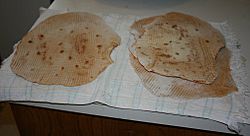Krotekake facts for kids
 |
|
| Type | Flatbread |
|---|---|
| Place of origin | Norway |
| Region or state | Hardanger |
| Main ingredients | Flour, yeast, water |
Krotekake is a special type of flatbread from Norway. It comes from the Hardanger region. People often decorate it with a cool cross-hatch pattern. Sometimes, outside of Hardanger, it's called hardangerkaker.
Krotekake is a thin pastry, a bit like a pancake or a tortilla. It's part of a bigger family of Norwegian pastries called lefse. The word krote means "a scroll," and kake means "cake" or "pastry." Krotekake can be dried and stored for a long time without needing a fridge.
Contents
Making Krotekake: A Fun Gathering
Making krotekake is a great chance for friends and neighbors to get together. In the countryside of Norway, people often gather in small groups. Usually, three or four people work together. The whole process can take most of the day. This gives everyone plenty of time to share stories and catch up. At the end, they have lots of this tasty food!
Preparing the Dough
The first step is to mix a simple whole-wheat yeast dough. Then, you let the dough rise. Once it's ready, you pull off a small piece. This piece should be about 1.5 inches (3.8 cm) wide.
You shape this piece into a ball. You do this by tucking the edges of the dough under. If the dough feels sticky, you can add a little flour. You want a smooth ball with a small dimple on the bottom. Place the ball dimple-down on a floured surface. It's good to have a few balls ready so they can rest for a minute or two.
Rolling the Dough Thin
The next job is to roll the dough into a round shape. You use a smooth rolling pin. First, roll the dough until it's about 3 to 4 inches (10 cm) wide and 1/2 inch (1.2 cm) thick.
Then, flip it over and roll it again. Keep rolling until it's much larger and thinner, like a disk. If it starts to stick, flip it onto a fresh dusting of flour. You keep flipping and rolling until it's about 1/8 inch (0.3 cm) thick and 12 inches (30 cm) wide. If it sticks badly, you might need to scrape it off and start that piece over.
Adding the Special Pattern
Now comes the fun part: using a special rolling pin. This pin has deep grooves that are about 1/8 inch wide and 1/8 inch apart. It also has cuts going across it. When you roll this pin firmly over the dough, it presses a cross-hatch pattern. This pattern helps seal the top and bottom of the dough together.
Sometimes, a guest or a child learning the tradition gets to use this special rolling pin. It's a great way to involve everyone!
After rolling, the dough might stick a little to the table. A lefse stick helps here. It's a thin, flat wooden stick, about 2 feet (0.6 m) long. You slide it under the krotekake to lift it from the table. You can also use it to scrape any leftover dough from the table or rolling pin.
Cooking the Krotekake
The cook takes the patterned round and places it on a hot, flat grill. The grill is usually around 400°F (200°C). The cook checks the temperature by seeing how fast a drop of water boils off. The grill isn't oiled; it relies on extra flour to stop sticking. Any burnt flour needs to be brushed off regularly. In a traditional oven, you might toss the round onto the grill because there isn't much space.
Each step in making krotekake takes about the same amount of time. This helps the team work together in a good rhythm. If there's a fourth person, they often stack the finished krotekake as it dries. Then, they divide it up for everyone who helped. People can often switch jobs, too, depending on what they like to do.
In Hardanger, many homes have a special arched oven in a separate building. This is where krotekake is cooked. Having the oven in a separate building helps prevent house fires. The arched oven reflects heat, so the krotekake cooks on both sides at once. You don't even need to flip it!
See also
 In Spanish: Krotekaker para niños
In Spanish: Krotekaker para niños

